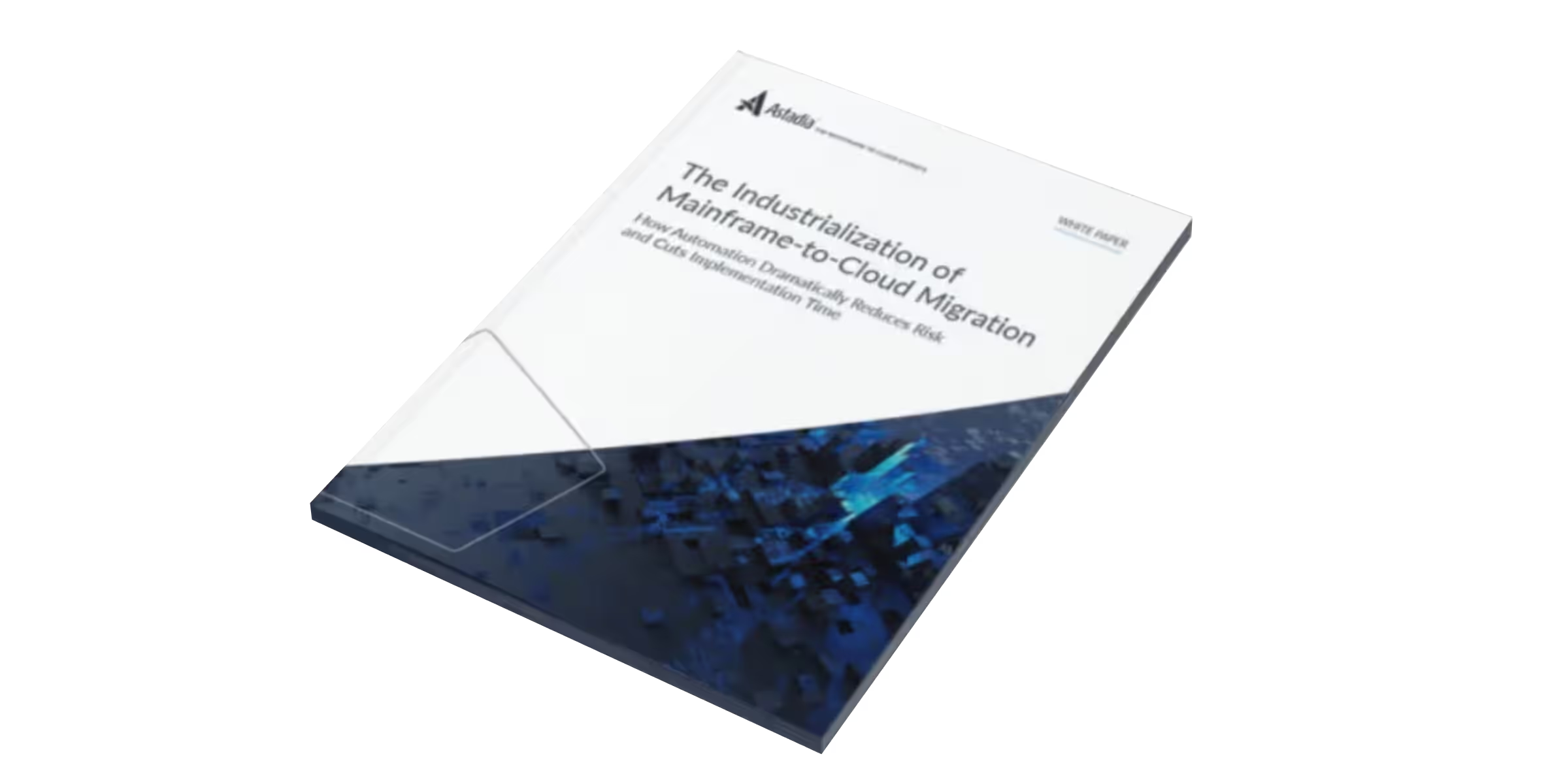At Astadia, we often begin conversations about mainframe modernization by talking about the immediate benefits that are clear, unequivocal, and easily measurable. For example, many of our clients are seeking to reduce their operating costs, get ahead of the mainframe talent shortage, or take advantage of modern cloud platforms and the myriad of services they provide. Those benefits are substantial, and they invariably provide a strong business case for moving forward with legacy modernization.
There is a much larger context to mainframe modernization, though, which tends to be more difficult to measure or even to articulate at times. Modernization opens the door to innovation. It enables digital transformation. Mainframe modernization projects bring agility to the software development process. They make it possible to integrate more easily with commercial off-the-shelf software and cloud-based SaaS applications. Modernization opens the door to robust data analytics, data enrichment, and artificial intelligence applications.
See how the U.S. Air Force modernization project accelerated the delivery of artificial Intelligence, machine learning, and advanced data analytics.
This article will be the first in a series of posts about what becomes possible after your mainframe modernization project. We will look at some of the opportunities that emerge when an organization moves to platforms and systems that more easily lend themselves to digital transformation. Our focus in this article will be the insurance industry. Let’s look at a few examples of what kind of change is possible following the completion of your mainframe modernization project.
Use Case #1: Leveraging Location
Geospatial data enrichment brings context to virtually any information. In the insurance industry, adding location context presents a wide range of opportunities to enhance value. Ultimately, the insurance business is about accurately assessing and pricing risk. If you underestimate risk, you’ll lose money on those policies. If you overestimate, you’ll be priced too high relative to the competition.
Historically, location-based risk assessment has been calculated based on fairly coarse-grained criteria; for example, by zip code. A finer-grained analysis using enriched geospatial data can more be used to calculate risk far more accurately, though. A homeowner who lives on a quiet cul-de-sac, for example, may be less likely to experience an accident pulling out of their driveway than someone who lives along a busy thoroughfare. It’s a small but potentially meaningful difference.
Risk assessment on homeowner policies, likewise, can benefit from geospatial analysis. Enriched data can provide a highly detailed picture of properties and risks, including precise proximity to combustible materials and bodies of water. Knowing a property’s address is a good starting point, but having information about the precise location of buildings on the property and the relative position of potential hazards is even better. Insurers who use location context to develop a more refined methodology for risk assessment will have a competitive edge over those who do not.
Use Case #2: Know Your Customer
Given the flood of information available from mobile devices, clickstream analysis, and third-party sources; it’s not surprising that smart businesses are doing everything they can to make use of all the data they can get about their customers and prospects. Insurance companies that sell a mix of products to individuals and businesses may struggle to develop a true360° view of their customers.
Imagine, for example, an entrepreneur who owns two small businesses, a home, and several vehicles. She is married, with several teenage children living at home (two who have drivers’ licenses) and one in college. In total, there are five drivers, two homeowners, two businesses, and an array of opportunities to provide both commercial and personal policies. If an insurer is unable to connect those dots, then how well do they really know their customer?
While most of our data is oriented around known entities such as a “customer”; our real-world example demonstrates that life is more complex than that. Data enrichment and advanced data analysis tools make it possible for us to develop that 360° view; but in order to do so, we need to break down the silos. We need to connect a myriad of different data sources, from mobile to clickstream to unstructured data, and tie those together in away that makes the organization more effective at reaching customers and prospects with the right messages at the right time. Modernization makes that possible.
Use Case #3: Smart Claims Management
Effective claims management is often a matter of identifying the cases that are most likely to escalate, then getting ahead of the problem before it becomes a major issue. That may include sentiment analysis built upon case file information containing large amounts of unstructured data. If medical records are involved, it may include sophisticated parsing of doctors notes, charts, and other medical information that can provide the basis for a detailed risk assessment.
With AI & machine learning applications, claims can be ranked according to legal or medical risk. Claims managers can allocate their most experienced people to high-priority cases and take pre-emptive action where necessary to bring high-risk cases to a faster resolution. Over time, AI & machine learning can help insurers to build a foundation for more effective claims management through a process of continuous improvement.
Use Case #4: New Business Models
No discussion of digital transformation is complete without addressing business models. While the chances of your company becoming the next Uber or Netflix may be slim, – there are nevertheless plenty of opportunities to innovate around existing products in ways that can expand a company’s addressable market or increase their share of wallet.
At least one major auto insurer is offering a usage-based pricing model enabled by a mobile phone app that tracks location, time, and driving behavior. It doesn’t replace the traditional auto insurance model; but it offers customers a choice that some might find attractive. It also gives the insurer a substantial amount of data that can be used to further refine risk assessment models.
In a legacy environment, that kind of innovation is considerably more difficult than with modern, interconnected cloud-based systems. Yes, you can connect your legacy systems to modern distributed platforms; but the level of integration and the speed at which it can be achieved is considerably greater after a mainframe modernization project has been completed.
There are, of course, numerous other examples of digital transformation made possible (or at the very least, made substantially faster and easier) by modernizing legacy systems. Customers who work with Astadia have achieved operating costs savings in the high double digits, sometimes exceeding 90%.
See how Meredith Corporation's modernization project reduced annual system operating costs by over 90%.
As the shortage of experienced mainframe talent grows worse, many organizations have recognized the need to modernize. In the long term, however, it is the world of new innovations made possible by modernization that provides the most compelling case for moving forward.
If your organization is considering a legacy modernization project, or if you have already started down the road in that direction, we would love to speak with you. Contact us today to talk about your project.
Related news
Related white papers:
Astadia Migration Factory
Learn what the industrialization of mainframe to cloud migration entails and how automation dramatically reduces risk and cuts implementation time in mainframe migration projects.
View more
Let's Talk
Get in touch with our experts and find out how Astadia's range of tools and experience can support your team.
contact us now







